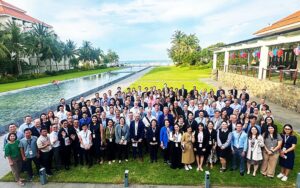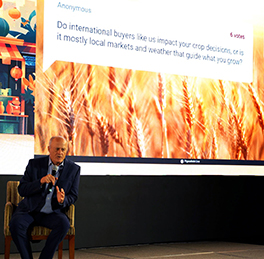Asian conferences celebrate past and prime future market opportunities
Getting U.S. wheat customers from across Asia together in one place requires a lot of organization and support from the entire U.S. wheat industry.

In late May, U.S. Wheat Associates (USW) was able to pull it off.
For the very first time, USW held the North Asian Marketing Conference (NAMC) and South and Southeast Asian Marketing Conference (SSEAMC) in one place, back-to-back. Aptly themed “Legacy of Success,” the two conferences allowed USW to efficiently plan and execute these two high-impact events.
“The idea was that we could have one set of experts and speakers come to the region and offer their expertise in one trip,” explained Joe Sowers, USW regional vice president for South and Southeast Asia. “We leverage the investment in their travel costs, and we’re able to include so many more people. Our North Asia conference had 100 participants, and in South and Southeast Asia, we had more than 200 participants.”
During USW marketing conferences, the goal is simple, yet complex: experts from each aspect of the U.S. supply chain share information on all U.S. wheat classes. At the same time, customers can ask questions and provide immediate feedback.
Another new twist was included this year at SSEAMC, which took place May 26-28. For the first time, USW conducted a full day of business-to-business meetings.
“We set up 260 meetings between exporters and buyers from across the region,” Sowers explained. “The idea was to help establish new relationships by setting up 20-minute meetings. Each exporter had its own booth, and representatives from each exporter welcomed a team of buyers and millers every 20 minutes. This new addition to the program was something they hope to see
again. I think we can spread it out to other conferences around the world to get established. These relationships are especially important, to bring buyer and seller
together in one place.”
Partnerships formed between the U.S. wheat industry and customers in Japan, South Korea, and Taiwan decades ago were revisited during the NAMC, held May 21-23.

More than 100 millers and wheat buyers from the three countries participated, joined by U.S. wheat farmers, state wheat association executives, exporters, and a host of milling, wheat foods, and transportation experts.
“It’s a chance for us to get together in one place and trade information about the markets, the U.S. wheat crop, the economics of trade, transportation, and all of the things that make up our business,” said USW President Vince Peterson. “It’s also a chance to cement relationships. Some of these relationships we’ve had for an exceptionally long time in these markets. This conference has been a tremendously valuable tool for that purpose.”
USW Chairman Clark Hamilton presented an “Outlook for U.S. Wheat Farmers” during the conference. He shared with attendees a perspective on global trade — from a producer’s point of view.
“I’ve been on board team trip visits to quite a few of the mills represented here, and several of the customers here have been on trade team visits to my family’s farm,” Hamilton, who grows wheat in Ririe, Idaho, said after his presentation. “So, there is familiarity, and that comes from building relationships over the years. The U.S. Wheat Associates staff does a fantastic job with this conference, and our customers are quick to express their appreciation for bringing everyone together.”
USW Taiwan country director, Ji-I Huang, said customers in his country look forward to blending with wheat buyers and millers from other countries.
“Japan, South Korea, and Taiwan have similar consumption trends and backgrounds, so it is a good chance for all of us to exchange information with each other, and our meters can also improve their business,” said Huang.
Customers at the NAMC were impressed by the presence of U.S. wheat farmers and their willingness to interact and answer questions about their production back home. Several attendees took advantage of the opportunity to directly pose questions to growers during the Q&A sessions USW conducted.
Speaking of production back home, Casey Chumrau, Washington Grain Commission CEO, said the USW conferences are a great conduit between milling industries in Asia and agriculture in the U.S.
“The producers of Washington know how important it is to be here with these markets; over 90% of our production is exported, and so they truly understand that their livelihoods depend on the relationships and the purchases that are made by these markets,” Chumrau, who participated in both conferences, said. “And they have been incredibly loyal customers to us. It’s a good reminder for all of us in the U.S. how important it is at these times to conduct market development and provide the information that is necessary for these customers.”
To gauge the response by customers to the two conferences, USW conducted real-time surveys with participants using a live service. Questions appeared on a screen in the conference hall, and attendees each had a remote device to input their answers. USW also used the service to field questions from the audience.
“What we found this year is that 96% of participants rated the conference as very good or an excellent value for their business,” said Joe Bippert, USW assistant director in South and Southeast Asia. “Some other highlights from the conference survey were that 97% stated that the conference was effective in demonstrating how U.S. wheat can be a profitable choice for their business, and 98% of the participants stated that the information from the presenters will impact their decisions.”
Regarding the business-to-business meetings organized by USW prior to the SSEAMC, surveys showed that nearly all who participated believed this new initiative was an effective platform to establish useful contacts with U.S. traders or potential business partners.
One trending item that came from the survey of NAMC and SSEAMC attendees was an indication that Asian mills feel that changes in the industry are increasing the demand for training, specifically in the areas of procurement and contracting, baking sciences, and milling.
“Luckily, customers indicated that activities by U.S. Wheat Associates are supporting those efforts, with marketing programs, such as the contracting for value workshops and procurement courses, improving their ability to make buying decisions, and influencing their interest and ability to use U.S. wheat in their operations,” said Bippert. “Overall, it was clear that
U.S. wheat programs are well designed to train the milling industry in the areas where they have indicated that there is the greatest need and that those activities are having the desired impact for them to see the value of U.S. wheat classes.”
This article originally appeared in the July 2025 issue of Wheat Life Magazine.
Ralph Loos
Director of Communications, U.S. Wheat Associates
